KEY POINTS
- U.S. public officials, health-care workers and epidemiologists are being hampered by a dearth of data on exactly how far and how fast the coronavirus is spreading.
- That lack of data in the U.S. is largely the result of delays in rolling out widespread testing in the early stages of the outbreak.
- To better track the speed of pandemic’s spread, CNBC analyzed two months of data on the pace of growth of new cases in U.S. states and in countries around the world.
As U.S. public officials, health-care workers and epidemiologists struggle to track the course of the coronavirus pandemic, they are being hampered by a dearth of data on exactly how far and how fast the virus is spreading.
Despite frequent updates by the news media, public health agencies and independent researchers tracking the outbreak, the available data represents only a portion of the total number of cases, many of which have gone unreported.
That lack of data in the U.S. is largely the result of delays in rolling out widespread testing in the early stages of the outbreak.
“Without knowing the extent and availability of testing, it is very hard to know what to make of the reported numbers,” said Yonatan Grad, a professor of Immunology and Infectious Diseases at the Harvard T.H. Chan School of Public Health. “For the U.S., when we see reports of numbers, they are best understood not as new cases but as identified cases where the true number of cases is unknown.”
But as testing becomes more widespread and the number of confirmed cases rises, a sharper picture is beginning to emerge of the pace of the spread of the virus.
To better track the speed of the pandemic’s spread, CNBC analyzed two months of data collected by researchers at Johns Hopkins University from multiple sources, including the World Health Organization, the U.S. Centers for Disease Control and Prevention, and various other national and local public health agencies around the world. The analysis looks at the pace of growth of new cases in U.S. states and in countries around the world beginning from time the outbreak began to accelerate. (To make that comparison, we adjusted each time series to start on the day each country or state began reporting more than 100 confirmed cases.)
Total case tallies
Much of the attention on data tracking the coronavirus has centered on charts and maps showing the total number of cases reported so far from around the world. As the source of the outbreak, for example, China has reported more than 80,000 confirmed cases so far, the most of any country.

In the U.S., New York state has recently reported the largest number of cases – more than 11,000 as of March 21. That was nearly half of all U.S. coronavirus cases reported by that date in the Johns Hopkins database. New York state independently reported more than 15,000 confirmed cases on Sunday.
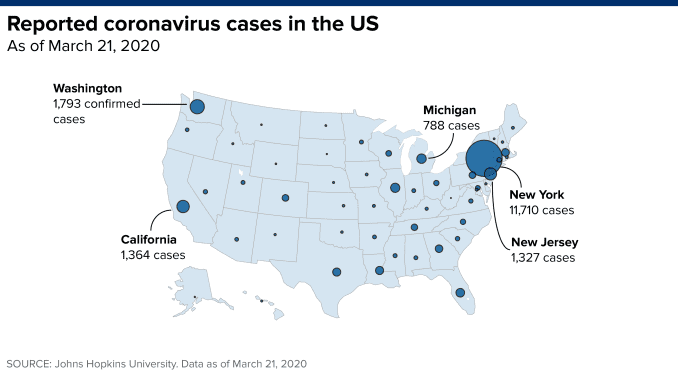
But that focus on total cases overlooks the critical question of how fast the virus is spreading.
Cumulative case counts don’t account for how many patients have recovered. They also don’t account for lags in reporting cases and differences in reporting methods.
“When people get sick especially in the context of a new outbreak, it takes a while to move them through the detection pipeline and the diagnostic pipeline,” said Dr. Caitlin Rivers, a senior scholar at the Johns Hopkins Center for Health Security. “So just because we saw a big influx in cases today, it doesn’t mean those people got sick today, but they probably got sick recently.”
Incomplete data
Cases can also be removed from the cumulative total if they are later found to have been incorrectly diagnosed.
So far, the available data on confirmed cases is also severely limited because it only accounts for cases that have been reported. These counts don’t include the unknown number of people who weren’t sick enough to go to a doctor or clinic, or who weren’t tested because there were not enough test kits available.
The result is that the number of cases reported daily provides an incomplete picture of the outbreak at any moment in time.
Still, researchers say that even incomplete data is critical to the task of controlling the spread of the illness. The hope is that widespread “social distancing” can “flatten the curve” tracking the spread of the pandemic – from the steep rise in the initial phases to a more gradual increase as efforts to contain the outbreak take effect.
Delaying the spread of the virus can mean the difference between delivering care to all those patients who need it and overwhelming local or national health-care systems.
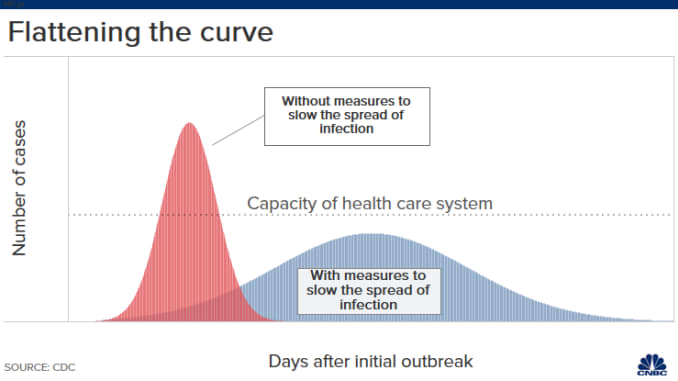
“We have to remind ourselves that it’s the slope (of confirmed cases),” said Dr. Bruce Y. Lee, Professor of Health Policy Management at The City University of New York. “But reducing the slope over time can have a big impact.”
Quick intervention
Countries that appear to have contained the outbreak have taken aggressive measures to test widely and isolate those found to have the most serious cases, according to Rivers.
In China and South Korea, she said, this policy of “case based intervention” centered on isolating and treating infected patients quickly to limit the spread of the illness. The impact of those measures can be seen in the the flattening of growth in the number of reported cases for those two countries, where the outbreak first began to spread widely.
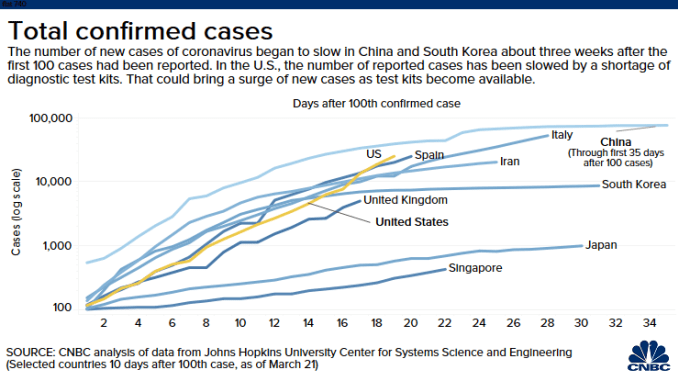
In the short term, the rapid increase in the distribution of coronavirus test kits in the U.S. will likely accelerate the pace of reported and confirmed cases.
At a White House press briefing last week, Dr. Deborah Birx cautioned that the rapid increase testing will likely skew the case counts until those tests are more widely available. “We will see the number of people diagnosed dramatically increase over the next four to five days,” she told reporters. “It will be five to six days’ worth of tests being run in 24 to 48 hours. So our curves will not be stable until sometime next week.”
That’s one reason the confirmed case counts have taken an alarming jump in New York state in recent days, after the state dramatically increased the availability of test kits.
New York Gov. Andrew Cuomo told reporters last week that the expanded testing represents an “exponential increase of what we have done.”
“What happens when the testing capacity increases, the number of positives increase by definition,” he said.
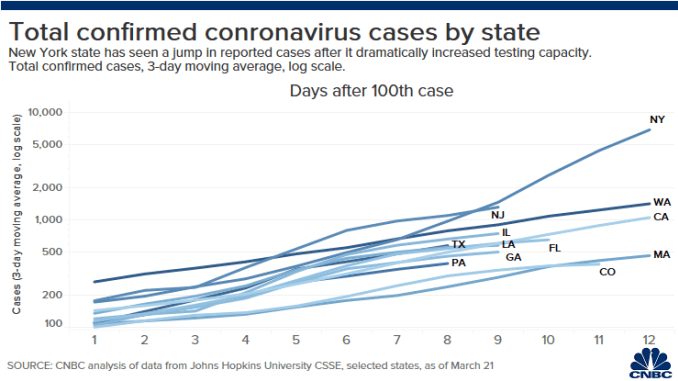
Another way researchers are tracking the speed of the pandemic’s spread is by focusing on the number of new confirmed cases reported every day. (One way to smooth out the day-to-day reporting inconsistencies is to look at the average number of new cases over several days.)
The goal is to focus less on the daily case counts and more on the trend over time, according to Rivers.
“When we see the number of new cases fall and continue to fall, we can say that we are influencing the epidemic curve,” she saidAs testing becomes more widespread, state and local public health officials will be better able to track the pace of the pandemic’s spread from one part of the U.S. to another. As county level data becomes available, those officials will be better able to target resources and allocate supplies to areas where the pandemic is spreading quickly.
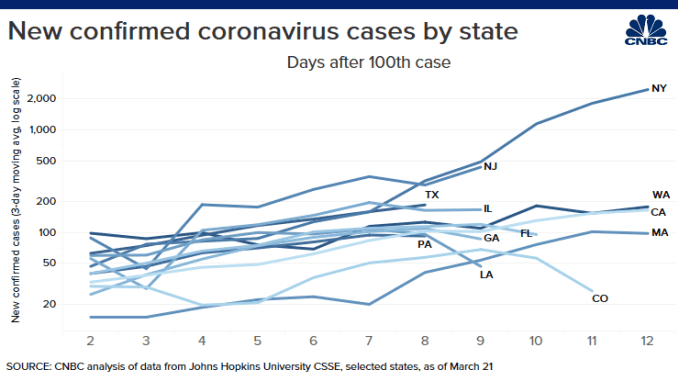
With hard data difficult to come by, it may be a while before it becomes clear just how much impact recent efforts to contain the spread — from widespread closure of schools, businesses and public events to mass self-quarantining — have had on the spread of the pandemic.
“How soon we expect them to have an impact and how soon we see the impact are two different things,” said Grad. “I think it will also be visible to some extent in what is happening in hospitals, the number of cases being seen, the number of critical care beds being used. But we don’t have good enough data there to be able to assess the trend.”
That’s why “the critical need is for testing,” he said.